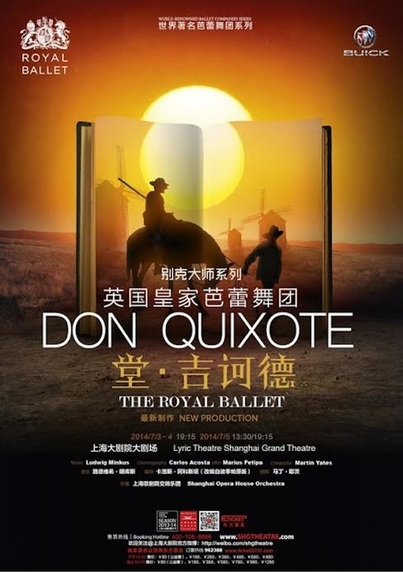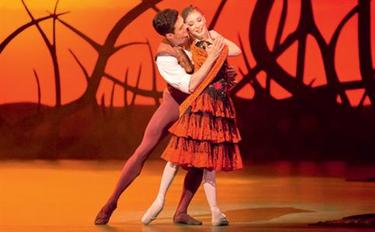Ballet | Don Quixote at Shanghai

The acclaimed new production of Don Quixote made its debut in China July 2014 at the Lyric Theatre. This one stars Carlos Acosta, a member of the Royal Ballet since 1998, bringing his take on Marius Petipa's classic from 1869. A lively ballet for all, with music by Ludwig Minkus, conductor Martin Yates, and the Shanghai Opera House Orchestra.
Choreography: Carlos Acosta after Marius Petipa
Music: Ludwig Minkus arranged by Martin Yates
Designs: Tim Hatley
Lighting design: Hugh Vanstone
Performed by the Royal Ballet (Covent Garden)
Conductor: Martin Yates
Shanghai Opera House Orchestra
2014/7/3 19:15 Marianela Nuñez / Thiago Soares
2014/7/4 19:15 Sarah Lamb / Federico Bonelli
2014/7/5 13:30 Akane Takada / Matthew Golding
2014/7/5 19:15 Marianela Nuñez / Thiago Soares
Royal Ballet Principal Guest Artist Carlos Acosta’s critically acclaimed new production of Don Quixote premiered at the Royal Opera House last September.
The adventures of the bumbling knight Don Quixote and his ever-faithful squire Sancho Panza have been the inspiration for countless ballets, of which one of the most well-loved is the version by 19th-century Russian choreographer Marius Petipa.
Best known as one of the worlds’ finest classical dancers, Acosta has danced the virtuoso role of Basilio many times, and now brings his unique and vibrant vision to the story, drawing on Petipa and with music by Ludwig Minkus, full of Spanish flair and atmosphere.
Don Quixote, which receives its China debut at the Shanghai Grand Theatre this summer, with its famously bravura Act III pas de deux and its infectious joie de vivre, makes for a wonderfully entertaining evening.
***
Choreography: Carlos Acosta after Marius Petipa
Music: Ludwig Minkus arranged by Martin Yates
Designs: Tim Hatley
Lighting design: Hugh Vanstone
Performed by the Royal Ballet (Covent Garden)
Conductor: Martin Yates
Shanghai Opera House Orchestra
2014/7/3 19:15 Marianela Nuñez / Thiago Soares
2014/7/4 19:15 Sarah Lamb / Federico Bonelli
2014/7/5 13:30 Akane Takada / Matthew Golding
2014/7/5 19:15 Marianela Nuñez / Thiago Soares
Royal Ballet Principal Guest Artist Carlos Acosta’s critically acclaimed new production of Don Quixote premiered at the Royal Opera House last September.
The adventures of the bumbling knight Don Quixote and his ever-faithful squire Sancho Panza have been the inspiration for countless ballets, of which one of the most well-loved is the version by 19th-century Russian choreographer Marius Petipa.
Best known as one of the worlds’ finest classical dancers, Acosta has danced the virtuoso role of Basilio many times, and now brings his unique and vibrant vision to the story, drawing on Petipa and with music by Ludwig Minkus, full of Spanish flair and atmosphere.
Don Quixote, which receives its China debut at the Shanghai Grand Theatre this summer, with its famously bravura Act III pas de deux and its infectious joie de vivre, makes for a wonderfully entertaining evening.
***
Review by Nancy Pellegrini (timeoutshanghai.com)

1 Jul 2014.
When talking about London’s Royal Ballet, certain words spring to mind. Grace. Elegance. Upper body tableaux that is without equal. Schooled on the subtlety and psychology of Kenneth MacMillan and Frederic Ashton, the company does what they do better than anyone on earth, and usually avoids everything else. That’s why in this era of shrinking arts funding and ever-discerning audiences, the decision to let principal guest artist and first-time choreographer Carlos Acosta mount a lavish, costly production of Don Quixote might just be, well, quixotic.
To begin with, this ballet standard is all style and little, if any, substance. Although most companies follow Alexander Gorsky’s 1900 version, Acosta goes back to basics with Marius Peptia’s original 1869 creation – but in all of them, Cervantes’ story is unrecognisable. Other than smoothing over some lovers’ quarrels, Don Quixote is an observer, while Sancho Panza is a slapstick foil. What makes the ballet a classic is the extraordinary technical requirements and the raucous sense of fun. This is a non-narrative that strings together loosely connected scenes that share little other than bold, beautiful flair – which suits Russian, Cuban and even American dance companies, but it is something which the Royal Ballet has traditionally struggled with.
But this time reviews have been largely positive; criticism covers structural problems in Act I and general discomfort in the corps de ballet, while pointing out lively new interpretations and excellent performances, most notably by Marianela Núñez (Kitri). Although the 40-year-old Acosta debuted in London, he is sitting Shanghai out, installing Thiago Soares as the ‘A Cast’ Basilio. Overall, this is a classic ballet by an excellent company, and if you haven’t seen either one yet, you should. Maybe by now they’ll be enjoying themselves.
***
When talking about London’s Royal Ballet, certain words spring to mind. Grace. Elegance. Upper body tableaux that is without equal. Schooled on the subtlety and psychology of Kenneth MacMillan and Frederic Ashton, the company does what they do better than anyone on earth, and usually avoids everything else. That’s why in this era of shrinking arts funding and ever-discerning audiences, the decision to let principal guest artist and first-time choreographer Carlos Acosta mount a lavish, costly production of Don Quixote might just be, well, quixotic.
To begin with, this ballet standard is all style and little, if any, substance. Although most companies follow Alexander Gorsky’s 1900 version, Acosta goes back to basics with Marius Peptia’s original 1869 creation – but in all of them, Cervantes’ story is unrecognisable. Other than smoothing over some lovers’ quarrels, Don Quixote is an observer, while Sancho Panza is a slapstick foil. What makes the ballet a classic is the extraordinary technical requirements and the raucous sense of fun. This is a non-narrative that strings together loosely connected scenes that share little other than bold, beautiful flair – which suits Russian, Cuban and even American dance companies, but it is something which the Royal Ballet has traditionally struggled with.
But this time reviews have been largely positive; criticism covers structural problems in Act I and general discomfort in the corps de ballet, while pointing out lively new interpretations and excellent performances, most notably by Marianela Núñez (Kitri). Although the 40-year-old Acosta debuted in London, he is sitting Shanghai out, installing Thiago Soares as the ‘A Cast’ Basilio. Overall, this is a classic ballet by an excellent company, and if you haven’t seen either one yet, you should. Maybe by now they’ll be enjoying themselves.
***
